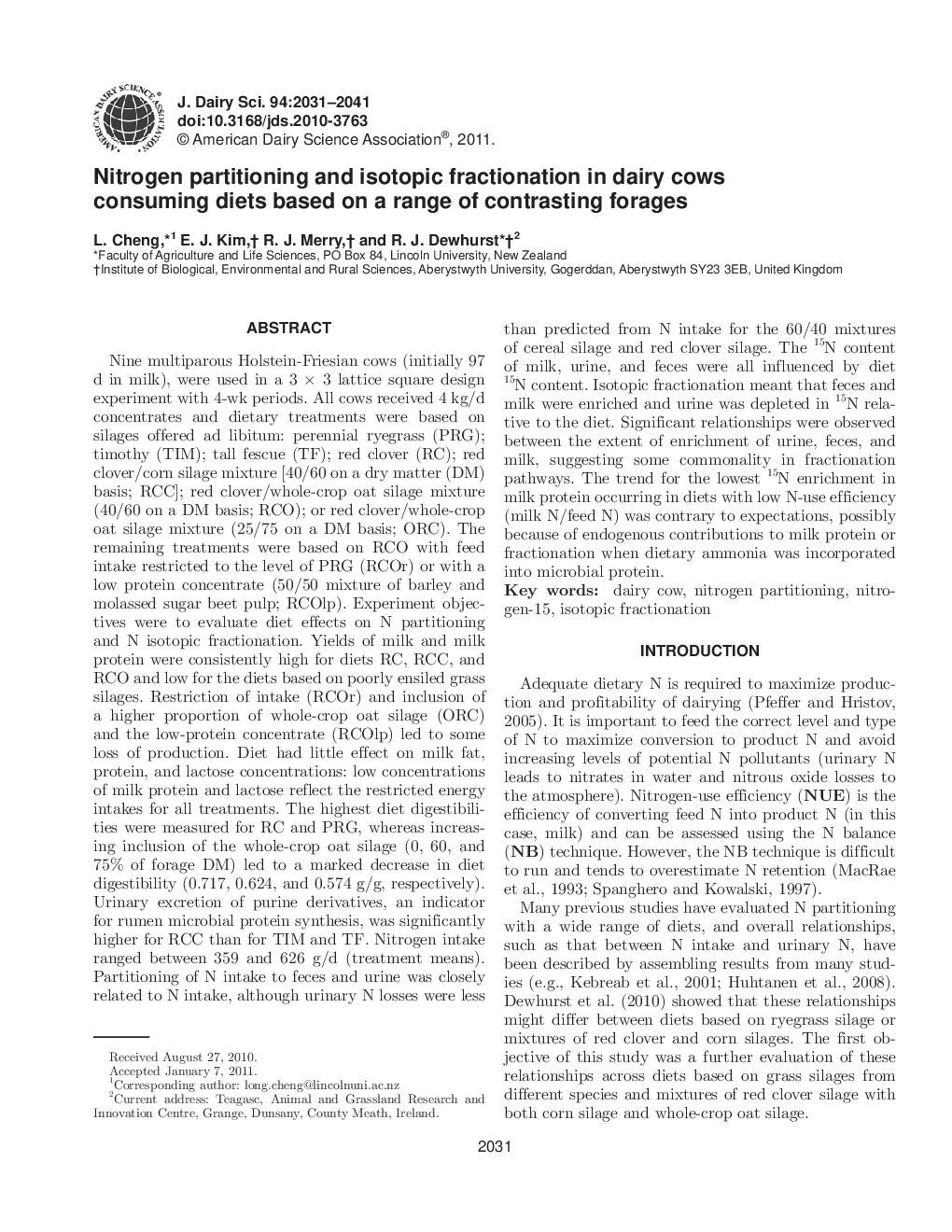| کد مقاله | کد نشریه | سال انتشار | مقاله انگلیسی | نسخه تمام متن |
|---|---|---|---|---|
| 10982171 | 1108088 | 2011 | 11 صفحه PDF | دانلود رایگان |
عنوان انگلیسی مقاله ISI
Nitrogen partitioning and isotopic fractionation in dairy cows consuming diets based on a range of contrasting forages
دانلود مقاله + سفارش ترجمه
دانلود مقاله ISI انگلیسی
رایگان برای ایرانیان
کلمات کلیدی
موضوعات مرتبط
علوم زیستی و بیوفناوری
علوم کشاورزی و بیولوژیک
علوم دامی و جانورشناسی
پیش نمایش صفحه اول مقاله

چکیده انگلیسی
Nine multiparous Holstein-Friesian cows (initially 97 d in milk), were used in a 3Â ÃÂ 3 lattice square design experiment with 4-wk periods. All cows received 4Â kg/d concentrates and dietary treatments were based on silages offered ad libitum: perennial ryegrass (PRG); timothy (TIM); tall fescue (TF); red clover (RC); red clover/corn silage mixture [40/60 on a dry matter (DM) basis; RCC]; red clover/whole-crop oat silage mixture (40/60 on a DM basis; RCO); or red clover/whole-crop oat silage mixture (25/75 on a DM basis; ORC). The remaining treatments were based on RCO with feed intake restricted to the level of PRG (RCOr) or with a low protein concentrate (50/50 mixture of barley and molassed sugar beet pulp; RCOlp). Experiment objectives were to evaluate diet effects on N partitioning and N isotopic fractionation. Yields of milk and milk protein were consistently high for diets RC, RCC, and RCO and low for the diets based on poorly ensiled grass silages. Restriction of intake (RCOr) and inclusion of a higher proportion of whole-crop oat silage (ORC) and the low-protein concentrate (RCOlp) led to some loss of production. Diet had little effect on milk fat, protein, and lactose concentrations: low concentrations of milk protein and lactose reflect the restricted energy intakes for all treatments. The highest diet digestibilities were measured for RC and PRG, whereas increasing inclusion of the whole-crop oat silage (0, 60, and 75% of forage DM) led to a marked decrease in diet digestibility (0.717, 0.624, and 0.574Â g/g, respectively). Urinary excretion of purine derivatives, an indicator for rumen microbial protein synthesis, was significantly higher for RCC than for TIM and TF. Nitrogen intake ranged between 359 and 626Â g/d (treatment means). Partitioning of N intake to feces and urine was closely related to N intake, although urinary N losses were less than predicted from N intake for the 60/40 mixtures of cereal silage and red clover silage. The 15N content of milk, urine, and feces were all influenced by diet 15N content. Isotopic fractionation meant that feces and milk were enriched and urine was depleted in 15N relative to the diet. Significant relationships were observed between the extent of enrichment of urine, feces, and milk, suggesting some commonality in fractionation pathways. The trend for the lowest 15N enrichment in milk protein occurring in diets with low N-use efficiency (milk N/feed N) was contrary to expectations, possibly because of endogenous contributions to milk protein or fractionation when dietary ammonia was incorporated into microbial protein.
ناشر
Database: Elsevier - ScienceDirect (ساینس دایرکت)
Journal: Journal of Dairy Science - Volume 94, Issue 4, April 2011, Pages 2031-2041
Journal: Journal of Dairy Science - Volume 94, Issue 4, April 2011, Pages 2031-2041
نویسندگان
L. Cheng, E.J. Kim, R.J. Merry, R.J. Dewhurst,